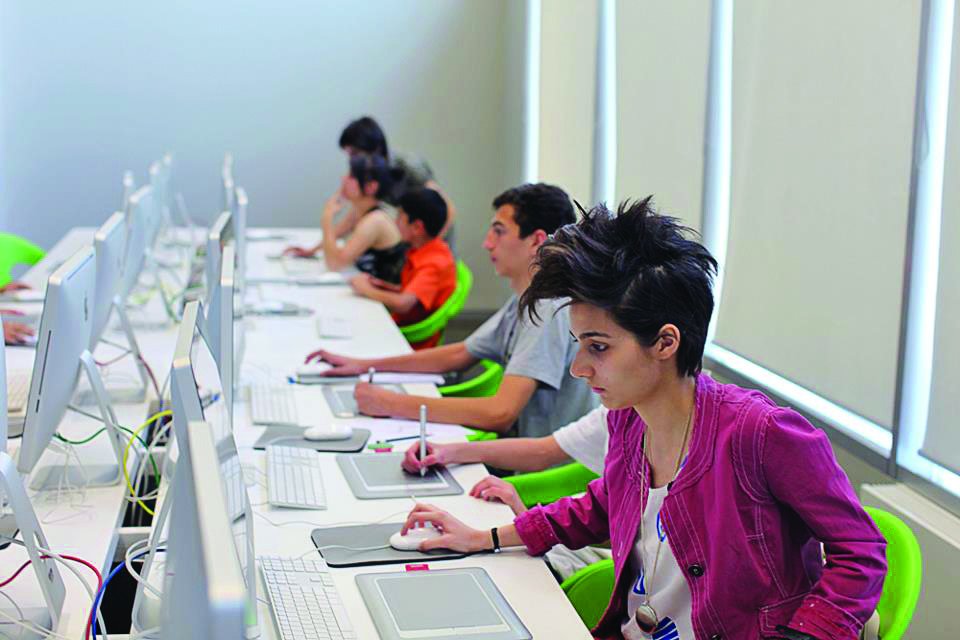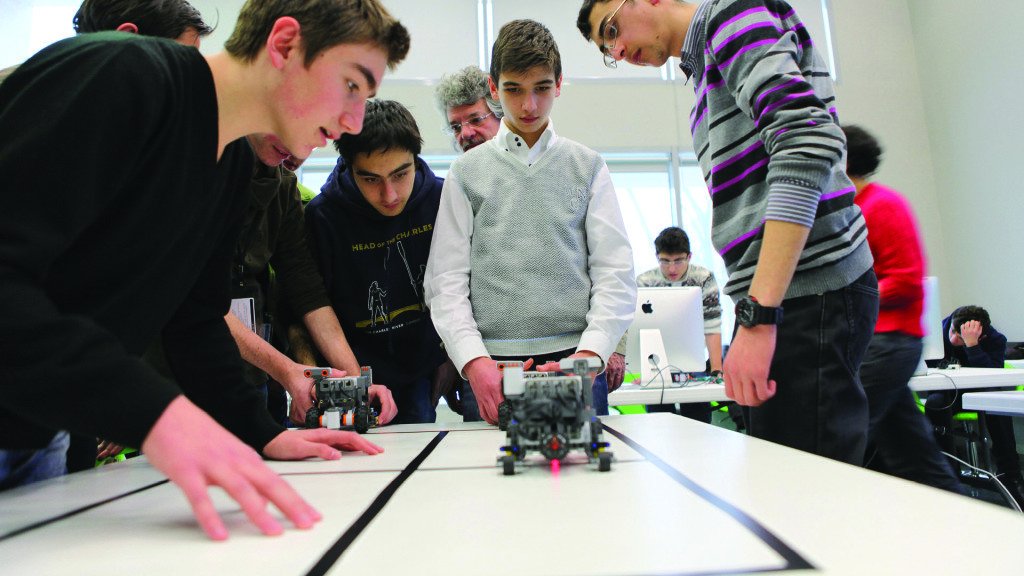“I want to become an architect, but I also want to become a good photographer,” Arevik Galoyan, 15, recently told the Armenian Weekly. “I’ve gained much from Tumo, starting with good friends to good knowledge,” she added.

Arevik is one of many students who attend workshops at the Tumo Center for Creative Technologies. Experts in animation, web development, game development, and digital media offer students a unique learning experience in a state-of-the-art facility that is unrivaled in Armenia.
Fully funded by the Simonian Educational Foundation, the center is hoping that the talents they cultivate will stay in Armenia. “Tumo enables students to be proactive, take initiative, and be confident while creating their own career path,” Tumo director Marie Lou Papazian told the Weekly.
“These qualities will help them find their place within their society. … They can be part of global developments without changing their country of residence,” said Papazian, adding that the center would soon have start-up incubators. Business incubators are designed to back the development of entrepreneurial companies by supporting them in a variety of ways, including marketing, networking, accounting, management, and access to loans. Studies have claimed that businesses that go through incubators have a nearly 90 percent survival rate.
The workshops are free of charge, and draw in students from all economic backgrounds. The center also welcomes children with disabilities—from autism to physical handicaps—in a region where disabilities often shut doors to opportunities and even education. Most students are between the ages of 12 and 16; some are older, between 17 and 19.
Arevik attends classes every day after school. She’s been a regular for two years. “I love workshops on photography,” she said. Over the summer, Arevik also participated in a workshop called “Items that Tell a Story,” taught by historian Vahe Tachjian, the director of Houshamadyan.org, and visual artist Silvina Der-Meguerditchian. She found the project, which aimed to reconstruct life in Ottoman-Armenian towns and villages, fascinating.

“[Tumo] offers its members a combination of self-paced virtual courses, specialized workshops, guest lectures, and multifaceted projects,” explained Papazian. “Students choose their activities based on their own preferences and are guided along their journey by learning coaches and accomplished professionals from around the world. Workshops are interactive, hands-on, and result-oriented. Being the fruit of highly challenging team efforts, each workshop culminates in a final product used online or in print, and presented during exhibitions, competitions, and festivals.”
The workshop sizes vary. Usually between 15 and 30 students, but sometimes as many as 45, attend them. The schedules vary as well, with some workshops meeting twice a week for two months, or every day for a shorter span of time. Overall, around two dozen workshops are taught every week.
Tumo’s space is as impressive as the workshops it offers. It is located in Tumanyan Park, one of the largest green areas in Yerevan. With more than 6,000 square meters of indoor space, Tumo boasts a movie theater, gaming room, brainstorming areas, labs, and a cafeteria. Students have access to the over 450 computers, specially designed futuristic furniture, 100 iPads, 3D printers, musical keyboards, and photo and video cameras in the center.

Digital media coach Nayiry Ghazarian has supported students as they have developed new skills, gained confidence in their abilities, and allowed their creative talents to take off. She remembers one instance, in particular, when photographs taken by a 15-year-old student nearly knocked her off her chair. “It was in Scout [Tufankjian]’s workshop where I had a student named Ani. She was shy and she barely talked in class. She was confused about her assignment—about what to do. The workshop was nearly ending and we had three sessions left. She suddenly came up to us—feeling uncomfortable—and she said, ‘I…have…pictures…of Barbies.’ Next thing we know, Scout and I are speechless looking at her underwater Barbie pictures. The theme was a birthday party,” recollected Ghazarian, whose job encompasses assisting in teaching workshops, helping kids understand assignments, and editing final projects.
Ghazarian, a third year student at the Gomidas State Conservatory, says her background in music influences the way she coaches at the center, where she’s been working for two years. “One of my favorite workshops is the photography workshop where students produce art through taking pictures instead of [creating] music,” she said.
Nineteen-year-old Anahid Talasyan began attending Tumo when the center first opened its doors to students three years ago. “When Tumo first opened, I expressed my wish to become a member. There, I could learn new developments in computer science and explore the fields of animation, website development, and digital media,” Anahid told the Weekly. Today, she attends classes two days a week—on Fridays and Saturdays. “Sometimes, I go more often than that, depending on the workshops and lectures,” she added.
Anahid has taken part in various workshops, but for her, the most interesting and rewarding was the workshop on “Telling Stories through Photography.” The class was run by Armenian-American photojournalists Eric Grigorian and Scout Tufankjian. “We didn’t even know who [Tufankjian] was,” confessed Anahid. Soon they would discover how Tufankjian’s iconic photographs of the Obamas brought her work to the spotlight. “I learned how to photograph, and to approach the subject matter with respect, since—putting aside everything else—the subject would later become the hero of the photograph,” Anahid added.
According to Papazian, workshops on animation at Tumo attract a specific group of students who are likely to pursue animation as a career. Digital media has a wider appeal. Regardless, students are encouraged to explore the four main fields that also include web development and game development. “Our wide variety of workshops, ranging from the beginner to the advanced, gives [students] an opportunity to experience each focus area and later concentrate on one of them,” she said.
Papazian is proud of her students’ work. “Tumo boasts multiple outstanding projects accomplished by our fellow students. One of the first successful projects in the series is a music video creation for Serj Tankian’s latest song ‘Uneducated Democracy,’” she said.
Students at Tumo also collaborated with filmmaker Atom Egoyan to produce original visual animations of Egoyan’s logo.
Furthermore, Tumo is the first in the region to present an iPad-based orchestra—TUMOrchestra—that performs symphonic and jazz compositions relying solely on iPads.
In January 2013, Tumo opened a wing in Dilijan, a resort town in Tavush, with the support of the Central Bank of Armenia. The town has been home to artists and filmmakers, but the population has been on a steady decline. The Central Bank recently moved most of its operations to Dilijan, as part of the government’s plans to revive the town, rendering it into a financial center in the region. “Presently, there are more than 200 teenagers enrolled in the program who come from Dilijan and other adjacent rural areas,” said Papzian. But Tumo’s expansion plans don’t end there. The center is planning to open another wing, with the support of the AGBU in Stepanakert, Karabagh’s capital.
Anahid is currently working with a group of similarly talented and creative students to bring an animation project to life. She hopes to become an expert in animation and web and graphic design. “It is because of Tumo that I have gained these new and useful skills. I’ve made many friends, learned teamwork, and developed my creativity,” she said.
Tumo’s mission has touched the lives of many young and talented kids, giving rise to a technologically savvy generation. The center’s work is a meaningful step in pushing the country to become a powerhouse of information technology. And it all starts with the youth.


Be the first to comment